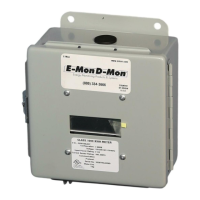Page 13
5.0 Monitoring Multiple Loads with One Meter
The Class 1000 meter provides extreme fl exibility by allowing additional sets
of current sensors to be used in parallel so that multiple load locations can be
monitored by one meter. This feature allows a totalized display readout from two
or more load circuits.
You may use parallel sensors to monitor specifi c breakers from one panel,
specifi c breakers from more than one panel, two or more complete panels, etc.
When paralleling current sensors, the following rules must be followed for
accurate readings:
Rule 1: Current sensors must be installed in complete sets of two, with a
maximum of three sensors installed in parallel per phase.
Rule 2: All sensors used in parallel must be of the same amperage rating (i.e.
100 amp, 200 amp, etc.) The rating is determined by the current rating
(amperage) of the Class 1000 meter. For example, a 200 amp meter
must use extra sets of 100 amp current sensors.
Rule 3: All locations being monitored must have the same power source. A 277
volt meter cannot monitor a 208 volt load nor can a meter monitor two
277 or 208 volt loads if they are from different originating power sources
or from different transformers.
Rule 4: The display readings must be multiplied by the number of sets of current
sensors installed. E.g. meter reading of 5 kWh with 2 sets of current
sensors....5 x 2 = 10 kWh (actual usage.)
NOTE: One set of current sensors equates to three sensors, one per
phase. The multiplier only applies when extra sets of current sensors are
installed on one meter. Therefore, if you are using only one set of two
sensors (one per phase) the multiplier is not required.

